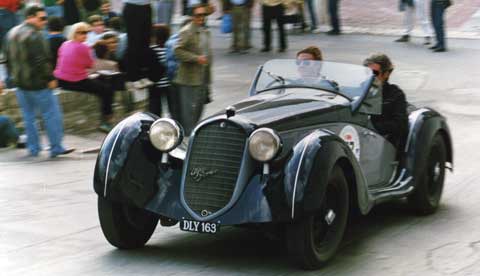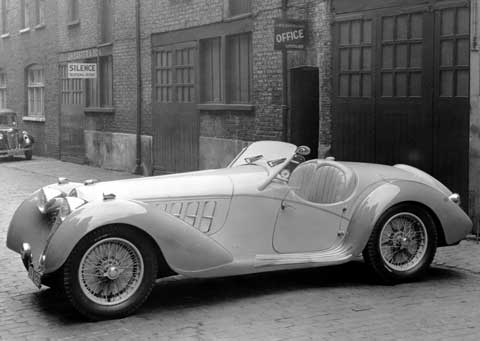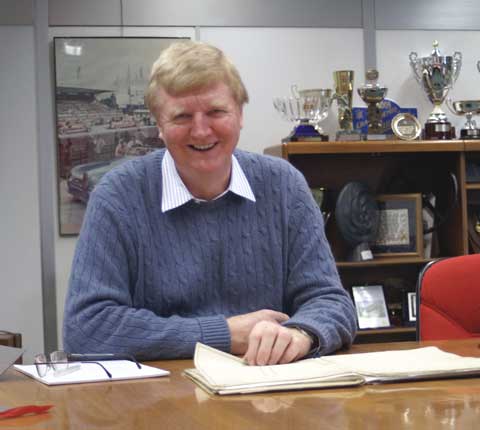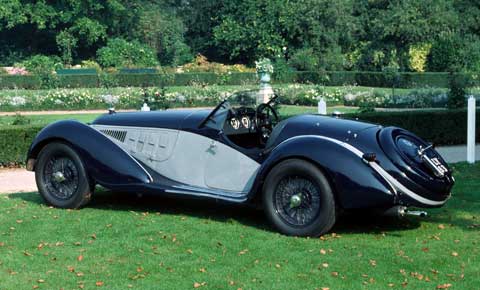
Simon Moore participating in the 1987 Mille Miglia with his 8C2900A Alfa Romeo.
Although consisting of only two books, the body of work achieved by Simon Moore is both enormous and highly significant. Moore is the author of “The Immortal 2.9” and the three volume set, “The Legendary 2.3.” Both books will stand for years as the last word on the subject. Last month, Parkside Publications released the second edition of the “Immortal 2.9” book. (read review).
Moore is an archeologist, an explorer blessed or cursed with the same kind of obsession that drove his British counterparts to search for the source of the Nile, the North and South poles, King Tut’s tomb and El Dorado. For most of his adult life he has traveled the world searching for information that will shed light on the history of all 43 Alfa 2.9s presumably constructed between 1936 and 1939 (not to mention the other Jano Alfas as well). But it is his abilities as a detective that allow Moore to uncover the mysteries of the ancient Alfa Romeos; he possesses the skills of both Howard Carter and the legendary Sherlock Holmes.
Below, Moore himself becomes the subject of inquiry.
When did you become interested in cars?
I really cannot recall a time when I was not interested in cars. Three of my mother’s sisters married people in the motor trade; one worked at Bellevue Garage in London pre-war (where Wilkie Wilkinson was the head mechanic), one was in car transport and the other was involved in building the GSM Delta in the UK. My father used to keep me amused as a small child on long car journeys by seeing if I could identify the car coming the other way before he did.
Why did you become interested in Alfas?
My mother bought me a copy of Kings of the Road by Ken Purdy, which introduced me to Alfas and other great marques, and the incredible exploits of Tazio Nuvolari. My copy of the book was later signed by Ken, date-lined 16th July 1968, in the Algonquin Bar in New York City, one of his favourite watering holes. Once interested in the history of racing, I became fascinated by Dick Seaman’s success in 1936 with a 10-year-old Delage, so arranged to see the car at Rob Walker’s garage in Dorking (near where I lived) in 1965. Whilst photographing the car, a passing motorist stopped and asked if he could buy some of the photos (as recounted on pages 770/771 and 960 The Legendary 2.3) and he had an 8C2300 (2311243). That led to an interest in Alfas.

The Moore 2.9A as it appeared in London in the late 1930s.
What significant cars have you owned and what do you own today?
I had a 6C1750 twin cam unblown Alfa whilst in College. After starting work, I owned a Maserati A6G (single cam) chassis number 2020 with Pininfarina bodywork and an engineless 212 Ferrari (chassis number 0165 EL) back in the late 1960s/early 1970s. The Ferrari was bodied by Abbott in the UK and looked like an over-grown Morris Minor convertible!! Probably the ugliest Ferrari ever! It went to pay the deposit on my first house. Today I have an 8C2900A Alfa Romeo from 1936 which started life as a Scuderia Ferrari ‘botticella’ sports-race car and was re-bodied for sale (as a new car!) by Alfa Romeo’s own carrozzeria. I also still have the 1962 MGA that I bought as the second owner in 1965.
Tell us about your daytime job and why you travel so much.
I am now retired after working for Shell for more than 35 years, but I traveled all over the world for them including living in Holland, South Africa, South Korea and Singapore. Even now, I still travel quite a lot both on family holidays and to do more research on cars.
What other books have you written besides the 2.9 and 2.3?
None. I started writing stories for magazines in the early 1970s and continue to do so today. In fact, thirty years ago, one could be more of a generalist and my stories covered Maserati, Ferrari, Mercedes etc as well as Alfa Romeo.

Doing what he does best; Simon Moore, very much at home in the Alfa Romeo archive room.
What inspired you to begin the Alfa 2.9 book?
In late 1971, Peter Hull asked me to add a “Where are they now” feature as a side bar to his article The Immortal 2.9 in Automobile Quarterly which appeared in 1973. When I moved to South Africa in 1984, I decided to put the individual histories from a hard covered exercise book onto my first computer. After some persuasion, I converted this into a manuscript for The Immortal 2.9 . Mal Harris was the main voice to persuade me, but Fred Simeone helped!
How does Cherrett’s Alfa 2.3 book differ from your three volume set?
Her book is 191 pages and covers the different body styles on the 8C2300s and the period racing history. It only identifies a few photographs of cars by chassis number and does not try to give complete histories of each car. It is a great book, just a different approach and scope.
How did you manage to keep enthusiastic about working on the 2.3. and 2.9 books?
I love the detective work involved in working out which car was which. Also there are lots of other Alfisti who spurred me on. Whenever I was feeling fed up with one aspect, someone would call with some exciting new photo find or whatever!
In regards to the 2.3 book, what was your favorite story out of the many interesting stories?
That’s impossible! Finding photos of a 1939 traffic accident still in the Swiss Police archives (see page 323) was amazing. Finding records from the early 1930s in a transport company’s archives (including chassis numbers) was also incredible (see page 10) and I have to thank Hans Matti for both. The whole Hell Nice story (see 2311213) was fascinating and Miranda Seymour has written a book just about that interesting lady driver. Finding the lovely photos of the first body on 2211086 was great as was working out all the African adventures of 2311203. One of the best stories is recounted by Robert Ford about his wife in the pool on page 699. But overall, I just love all the detective work!
In regards to the new 2.9 book, what was your favorite story in that?
The late Henry Wessells gave me the story of excavating the Missouri Barn Fire car (chassis number 412021) in his own words which was special (pages 211-4) and also finding photos taken the morning after the fire. Also I discovered that one car (chassis number 412012) had not been broken up (as per the first edition) but was in California so it now gets twelve pages rather than one! Photo discoveries are special like those of the crash during testing of a 1938 Mille Miglia car (pages 277/8). I guess, personally, it was exciting to discover color movie film from 1937 showing my own car in the UK and in Monaco.

Moore’s Alfa 2.9 at the 1989 Bagatellel Concours in Paris.
You mentioned that you might want to do a book on the GP Alfas next. Are you working on that now? Will it cover all Alfa GP cars through the modern era?
I am talking to my publisher about such a book but we have not yet agreed it. My vision is a book on the single seat GP cars with a longish introduction on the P1 and P2 cars of the 1920s, details on the 1930s GP cars (except the Monzas which are covered in The Legendary 2.3 ) and a longish postscript on the Tipo 158/159 which started life as a Voiturette (or Formula 2) car but was a GP car post war until 1951. Again, I am looking at a different scope compared to David Venables’ book First Among Champions and the Tipo 158/159 has been covered in a book of its own by Ed McDonough so that car will be mainly handled by using rarely seen photos.
Peter:
Glad to learn that a second edition of the 2.9 book is available and I will be ordering one shortly.
Would you please ask Simon Moore to contact me via email here in California. I would like to reconnect with him after some 30+ years (circa 1985).
We had been exchanging correspondence on early Ferrari research at the time. We were both relocating a lot in our respective careers back then and I lost track of his whereabouts. Thank you.
Simon Moore is a treasure. We are all grateful!
And I hope that he convinces his publisher to let him write a book on Grand Prix cars –THAT would be definitely worth waiting for.
Simon Moore also writes of Alfas in ww2 Eritrea. I would like to make contact with him over these and hope he would email me if he sees this note…. Victor Brumby
Would it be possible to get a contact for Simon Moore?
Thank you !
Vivian Ruesch (daughter of Hans)
My father, Art Stump, had a bit of involvement with the Alfa at Indianapolis after the war. He also worked on other Alfas throughout his Career. After his death, I cleaned out his shop and discovered a box of pistons (that I recall him telling me about) that are marked Alfa. Wonder if they’d be of use to some one in the Alfa world? I have photos ready to go if any interest.
Thank you. Al Stump